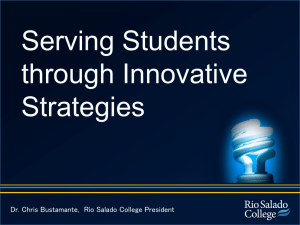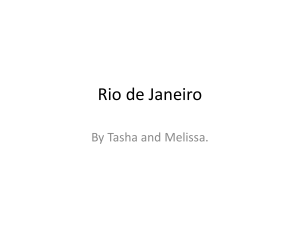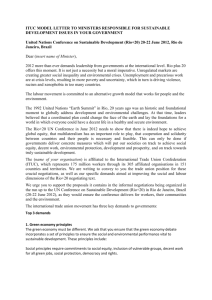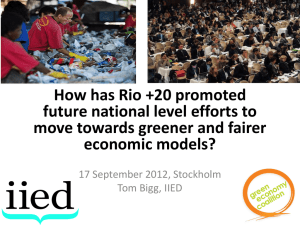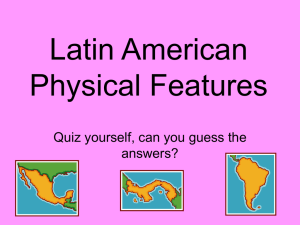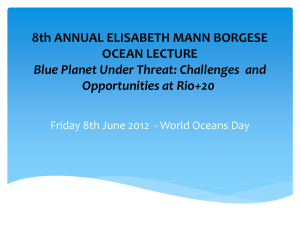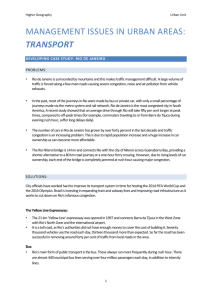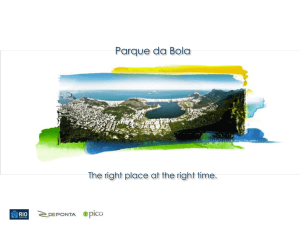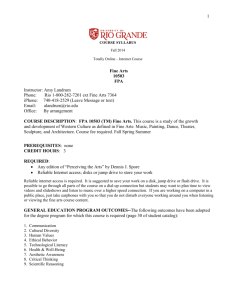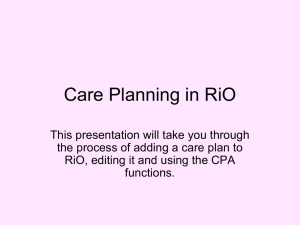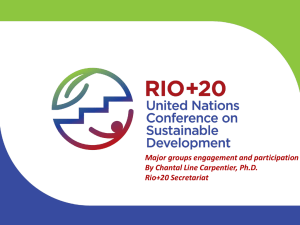Rio+20
advertisement
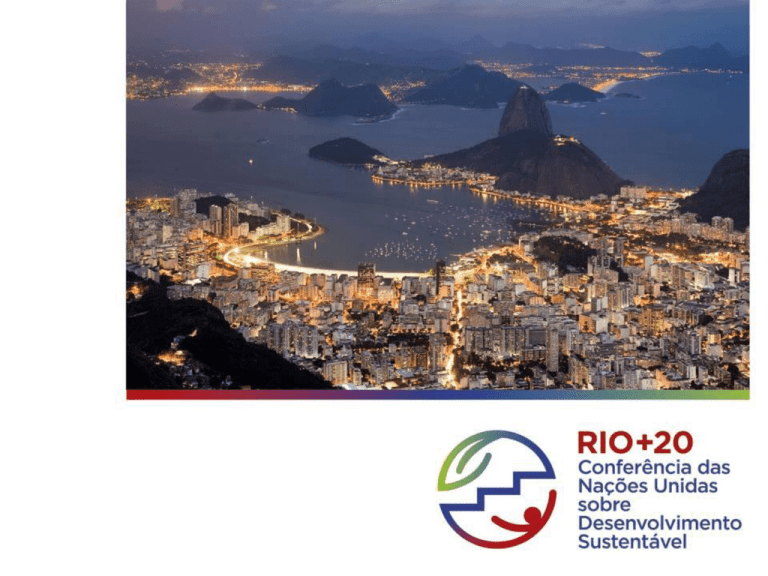
Conferência Rio+20 The United Nations Conference on Sustainable Development – Rio+20 Decided by UNGA Resolution 64/236 Objective: Renew development. political commitment for sustainable Main issues: • green economy in the context of sustainable development and poverty eradication; • the institutional framework for sustainable development . Rio+20 – Structure of the Conference • 13-15 June: last session of the Preparatory Committee (PrepCom III), expected to finish the negotiations of the Conference outcome. • 16-19 June: Dialogues on Sustainable Development. Expert panels, with the participaction exclusively of the civil society, to discuss key issues of the sustainable development debate: food security, water, energy, oceans, economy for sustainability (including production and consumption), innovation, cities and decent work & migrations. THE DIALOGUES WILL COMMUNICATE WITH THE HIGH LEVEL SEGMENT: . 20-22 JUNE: High Level Segment. Plenary meetings and round tables for the Heads of State. Debate on the proposals presented by the representatives of the Dialogues on Sustainable Development. Expected Conference Outcomes • Final Declaration. To be negotiated by all Parties, based on the Zero Draft document, just released by the UN Secretariat. An important, concrete and effective element of the outcome can be a set of Sustainable Development Goals, to be build in a complementary and coordinated way with the Millenium Development Goals, to be applied to both developed and developing countries. • Recommendations of the civil society. Products from the Dialogues on Sustainable development, will be debated by Heads of State at the High Level Segment. Might create a process after Rio+20. • Commitments Platform. Registry of Sustainable Development commitments by governments, organizations and other relevant actors. • National Processes. The legacy of the Conference for each country. The Meaning of the Conference • This is not a Conference only on the Environment, but on SD. This is about forging new development models, to be chosen by each country, respecting specific realities of economic, social and environmental conditions and priorities. . The Conference will happen in a very particular moment, when developed countries face a deep economic crisis. On the other hand, many developing countries are showing importante social, economic and environmental results. . The present crisis highlights that past choices have exhausted the world’s capacity to tackle the challenges of development. If social and environment concerns have been put aside by irrational economic growth, the economic crisis is a clear evidence that we cannot anymore run the planet the way we were doing. . In this context, the Conference will be a great opportunity to discuss new development models under the evidence that developing countries have a new and significative role as part of the solution of the crisis. Next Important Meetings •February: 20-22 – UNEP Global Ministerial Environment Forum – Nairobi, Kenya • March: •(tbd) Informal Consultations for Latin America and the Caribbean (negotiators) •19-20 – Meeting of the Ministers of the Environment of ATCO (OTCA) •19-27 – Negotiations on the outcome document (UN, New York) Next Important Meetings • April: •14-15: event on Rio+20 at the Summit of the Americas (Cartagena) •22: event on Rio+20, at the Annual Meeting of World Bank and IMF (Washington, DC) •23/apr-4/may: negotiations on the outcome document (UN, New York) A Conferência no Rio de Janeiro E F D A B C Espaços Oficiais: Barra da Tijuca Autódromo Arena da Barra a. Riocentro • Riocentro Parque dos Atletas Perímetro restrito às Nações Unidas, no qual serão realizadas as sessões plenárias e demais negociações oficiais da Conferência b. Parque dos Atletas • Local de exposição de países e empresas c. Autódromo e Arena da Barra c.1) Autódromo • Local de concentração e exposição da sociedade civil c.2) Arena da Barra • Ponto principal de retransmissão das atividades no Riocentro e de realização de atividades da sociedade civil
